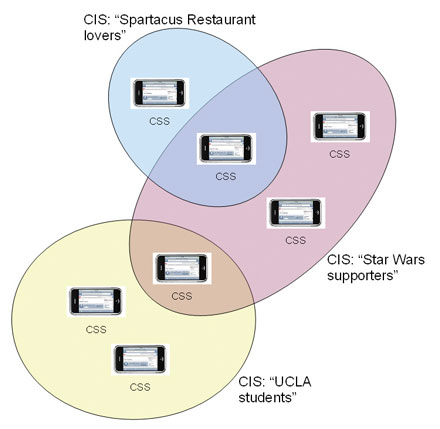by Kevin Doolin, Pierfranco Ferronato and Stefania Marrara
SOCIETIES will design and deliver a complete integrated package for the creation and management of Social Networks. The project will extend pervasive systems beyond the individual to dynamic communities of users.
Four out of ten of Alexa Top 500 Global sites (http://www.alexa.com/topsites as of November 2010) are Social Network sites. Barack Obama based his successful presidential campaign on social media and used them to obtain funding. LinkedIn, a Social Network of professional profiles, has seen its traffic doubling during the economical crisis. Although there is no doubt that Social Networks have altered the expectations of Internet users they are still mostly based on certain assumptions that limit their capabilities and prevent them from exploiting their full potential.
The first assumption is that the information stream that feeds a Social Network is provided interactively, through a Web browser, by the human members of the Network. This assumption has recently been partially invalidated with the adoption of contextual data sources for Social Networks (eg, Facebook Places and Facebook Deals).
The second assumption is that the mesh of relationships of a Social Network user is a “flat” network. In other terms, there is no way of defining hierarchies of networks where each node in a network at a given level is actually a network itself at a lower level in the hierarchy.

Figure 1: Mobile CSSs participate in one or more Community Interaction Spaces (CIS) which represent pervasive communities. Each CIS offers several characteristics to its CSSs such as a set of shared resources or services.
To overcome these limitations SOCIETIES, an Integrated Project of the EC Seventh Framework Programme, will investigate how pervasive data sources can increase the usefulness and accuracy of social networks. SOCIETIES will improve the utility of Future Internet services, merging social computing and pervasive computing, by focusing on four main objectives, which will represent the core for the definition of Cooperating Smart Spaces (CSSs).
CSSs are the building blocks for enabling pervasive computing in social communities, as they constitute the bridge between a user's context (devices, sensors etc.) and the user’s social community. A CIS (Cooperating Interaction Space) is a collection of CSSs and/or supporting infrastructure services, that intends to collaborate for mutual agreed purposes.
The four main objectives of SOCIETIES are:
- to facilitate communities creation, organisation, management and communication via Community Smart Spaces, where pervasive computing is integrated with social computing communities
- to provide an enhanced user experience – both for individuals and entire user communities – based on proactive smart space behaviour and dynamic sharing of community resources across geographic boundaries
- to design and prototype a robust open and scalable system for self-orchestrating Community Smart Spaces
- to evaluate, via three user trials, the usefulness and acceptance of the CSS software developed.
The main features that will be offered by a CSS to its user are the following:
- support the manual or automatic creation of static or dynamic communities. The creator of a community will be able to advertise it, or to invite particular users to join, and to specify principles governing the community itself. The system will be able to discover potential new members, also via social network site queries, as well as detecting and removing community members whose ties have become obsolete
- enable users to share resources with other community members in a seamless unobtrusive manner.
- support multiple techniques for the discovery of relationships and behaviours within communities.
- allow for the orchestration of multiple communities to which its owner belongs, maintaining a registry of super- and sub- communities in community hierarchies along with policies on information disclosure and service access to members of other related communities
- enable the proactive exchange of information on the situation, interests and resources of community members
- provide intelligent conflict resolution among the members of a community based on mediation and negotiation
- support ad-hoc communication at both intra- and inter- community levels, exploiting peer to peer communication techniques and wireless networking technologies.
The SOCIETIES consortium is coordinated by the Waterford Institute of Technology (Ireland), and includes the Heriot-Watt University (United Kingdom), Soluta.Net (Italy), the Deutsches Zentrum fuer Luft – und Raumfahrt Ev (Germany), the Zavod za Varnostne Tehnologie Informacijske Druzbe in Elektronsko Poslovanje (Slovenia), the Institute of Communication and Computer Systems (Greece), Lake Communications Ltd (United Kingdom), Portugal Telecom Inovacao Sa (Portugal), IBM Israel – Science and Technology Ltd (Israel), Institut Telecom (France), AMITEC Ltd (Greece), Telecom Italia s.p.a. (Italy), Trialog (France), Stiftelsen Sintef (Norway), and NEC Europe Ltd (United Kingdom). The project started on October 2010 and will end in March 2013.
Link: http://www.ict-societies.eu
Please contact:
Stefania Marrara
SOLUTA NET, Italy
E-mail:










